# EMSC 3002 ## Ductile Deformation and Shear zones - Louis Moresi (convenor) - **Romain Beucher** (lecturer) - Chengxin Jiang (lecturer) - Stephen Cox (curriculum advisor) Australian National University _**NB:** the course materials provided by the authors are open source under a creative commons licence. We acknowledge the contribution of the community in providing other materials and we endeavour to provide the correct attribution and citation. Please contact louis.moresi@anu.edu.au for updates and corrections._ <--o--> ## Resources 1. **Fossen, H, 2011.** *Structural Geology.* Cambridge University Press, 2nd Edition **Chapter 11** 1. **McClay, K.R. 1991.** *The Mapping of Geological Structures.* John Wiley & Sons. **Chapter 3** 1. **Park, R.G., 1995.** *Foundations of Structural Geology.* Blackie & Sons Ltd. **Chapter 2** 1. **Davis, G.H. and Reynolds, S.J., 1996.** *Structural Geology of Rocks and Regions.* 2nd Edition, John Wiley & Sons. **Chapter 7** <!-- 1. **Hatcher, R.D., 1990.** *Structural Geology - Principles, Concepts, and Problems*, 2nd Edition, Prentice-Hall --> <!-- 1. **Ramsay, J.G. and Huber, M.I. 1983.** *Modern Structural Geology. Volume 1: Strain Analysis.* Academic Press. --> <!-- 1. **Ramsay, J.G. and Huber, M.I. 1987.** *Modern Structural Geology. Volume 2: Folds and Fractures.* Academic Press. --> <--o--> ## Intended learning outcomes - Understand he concept of shear zones and how they form - Being able to differentiate between different types of shear zones - Understand theoretical aspects of plastic shear zones and what information they may contain <--o--> ## Transition from brittle to ductile beahviour with increasing depth <div> <div style='width:50%; float:left'> Gradual Brittle-Ductile transition from faults, which normally form in the upper crust, and ductile shear zones. The depth of the transition depends on the **temperature gradient** and the **mineralogy** of the crust. For a granitic crust it normally occurs in the range of 10-15km. </div> <div style='width:50%; float:right'> 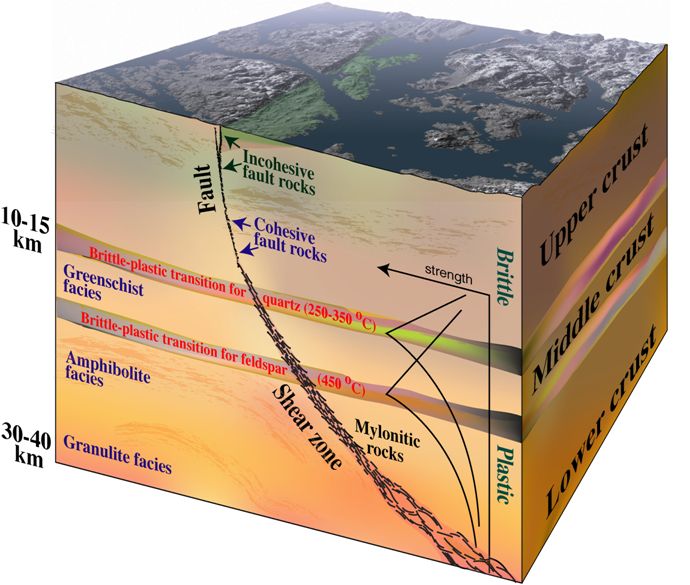 <!-- .element style="float: right" width="90%" --> </div> </div> <--o--> ## Shear zones <div> <div style='width:50%; float:left'> Strain and Shear strain in particular tend to localise into zones or bands. Shear zones are classic examples of strain localisation. *A Shear zone is a tabular zone in which strain is notably higher than in the surrounding rock.* Shear zones occur at almost any scale in any tectonic regime and form at any depth, almost most commonly in the plastic regime. The definition of shear zone is not restricted to a specific scale. </div> <div style='width:50%; float:right'> 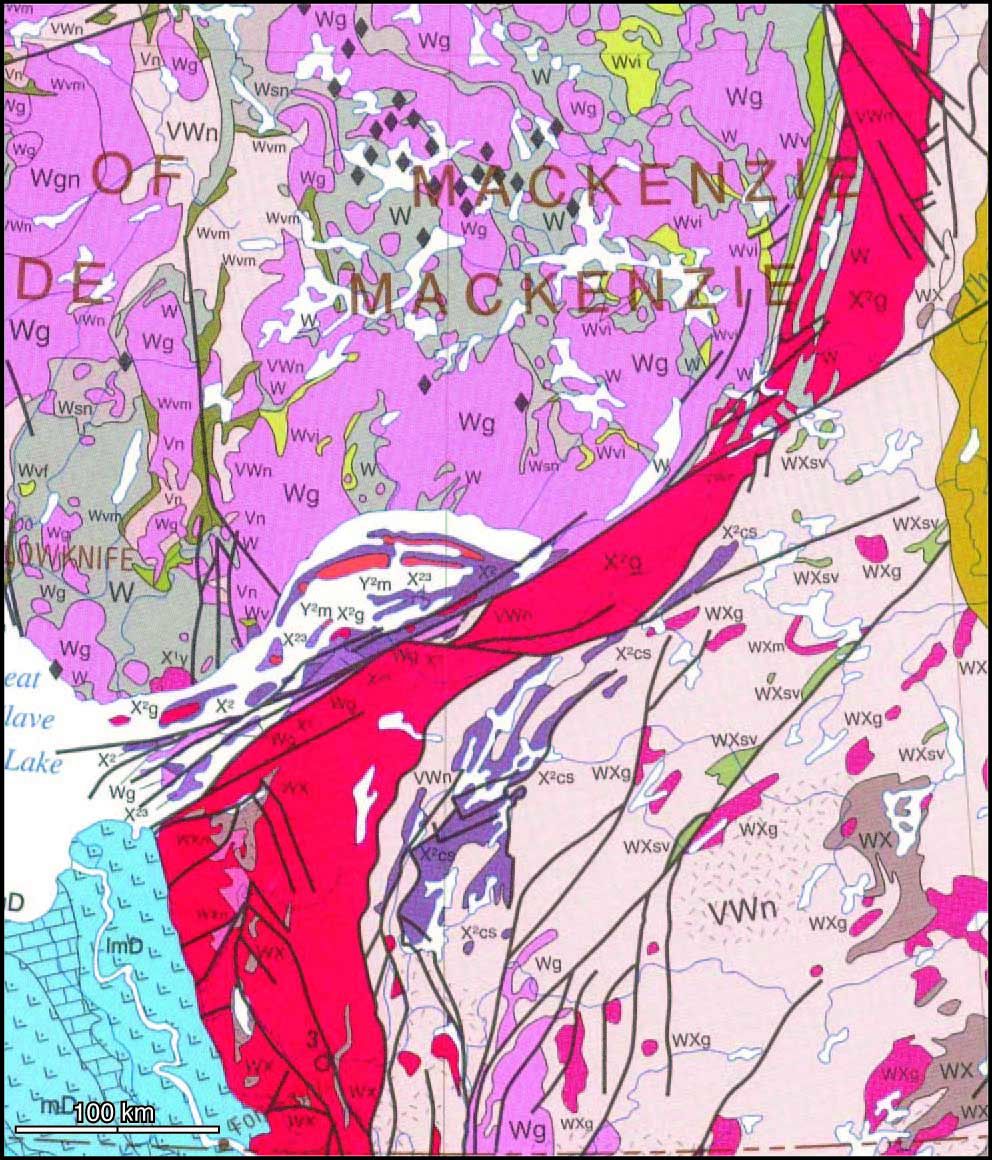 <!-- .element style="float: right" width="90%" --> </div> </div> <--o--> ## Shear zone: Definition <div> <div style='width:50%; float:left'> Strain and Shear strain in particular tend to localise into zones or bands. Shear zones are classic examples of strain localisation. *A Shear zone is a tabular zone in which strain is notably higher than in the surrounding rock.* Shear zones occur at almost any scale in any tectonic regime and form at any depth, almost most commonly in the plastic regime. The definition of shear zone is not restricted to a specific scale. </div> <div style='width:50%; float:right'>  <!-- .element style="float: right" width="70%" --> </div> </div> <--o--> ## Shear Zone: Definition Broad definition goes beyond **simple shear** deformation: - pure shear zones - subsimple shear zones - simple shear zones <--o--> ## Shear Zone: Definition Broad definition include **faults** and **ductile shear zones**. **shear zones** have a thickness that is significant relative to their displacement. <--o--> ## Shear zones: Classification ### According to style or distribution of strain - Ductile Shear Zones - Brittle-Ductile Shear zones - Brittle Shear zones (Fault) **Ductile shear zones** show a gradual distribution of strain. They show evidence of both plastic and brittle deformation mechanisms **Faults** or **non-ductile shear zones** are essentially formed by brittle deformation. Faults are a subclass of shear-zones. Other subclasses can be defined based on the kinematics, mineral deformation mechanisms, metamorphic grade etc. <--o--> ## Shear zones: Classification ### According to deformation mechanism - Plastic Shear Zone: Deformation occurs by crystal-plastic mechanisms (e.g. dislocation) and diffusion - Brittle mechanism shear zone: Deformation is dominated by brittle mechanisms (cataclasis, frictional sliding, rigid rotation) <--o--> ### What do we actually mean by "Ductile" and "Brittle"? <div> <div style='width:50%; float:left'> **Ductile** should be used about the style of deformation where passive markers preserve continuity. Ductility is scale dependent. **Brittle** (**style**) (as opposed to ductile) means that discontinuities form(ed) during deformation. In this usage the term is scale dependent. </div> <div style='width:50%; float:right'>  <!-- .element style="float: right" width="90%" --> </div> </div> <--o--> ### What do we actually mean by "Ductile" and "Brittle"? <div> <div style='width:50%; float:left'> **Brittle Mechanisms** is different: it means microscale frictional sliding and grain rolling. This makes the term **Brittle shear zone** a bit ambiguous unless the meaning of the term "brittle" is specified. The expressions **Brittle-style shear zone** and **Brittle-mechanism shear zone** are unambiguous. </div> <div style='width:50%; float:right'>  <!-- .element style="float: right" width="90%" --> </div> </div> <--o--> ## Shear zones: Classification ### Kinematic classification - compaction zones - simple shear zones - dilation zones <--o--> ### General Characteristics <div> <div style='width:50%; float:left'> - Shear zones are tabular zones of strain localization in the crust - Shear zones occur on all scales, from thin-section scale to those cutting the entire crust and involving hundreds of km of displacement - Like faults, Shear zones tend to involve simple shear but could also be influenced by other pure shear - High strain plastic shear zones develop mylonitic fabrics. - Shear zones may be reverse, normal, strike-slip or oblique. - Shear zones tend to have lower dips than faults </div> <div style='width:50%; float:right'>  <!-- .element style="float: right" width="90%" --> </div> </div> <--o--> ### Brittle versus plastic shear zones Elements within a shear zone can deform plastically and brittely at the same time. The deformation mechanism depends on temperature, pressure, strain rate, mineralogy, heterogeneities, amount of fluid available etc. and can vary through space and time. <--o--> ### Brittle mechanisms shear zones <div> <div style='width:50%; float:left'> - Brittle mechanisms dominate during shearing - Form at shallow depths (0-10km) in the brittle regime. - Can show ductile deformation and brittle deformation styles *mm-wide shear band in sandstone. The shear zone is ductile but deformed by brittle mechanisms (grain rotation and sliding)* </div> <div style='width:50%; float:right'>  <!-- .element style="float: right" width="70%" --> </div> </div> <--o--> ### What Deformation Mechanisms are brittle? <div> <div style='width:50%; float:left'> Brittle Mechanisms involve mechanical or frictional deformation of grains. There are 3 modes of deformation at the grain scale: - Frictional grain boundary sliding - Rigid rotation of grains - Grain Fracture In a Brittle shear zone grains flow through: - Granular flow (no grain fracture) - Cataclastic flow (abundant fractures) </div> <div style='width:50%; float:right'>  <!-- .element style="float: right" width="90%" --> </div> </div> <--o--> ### What Deformation Mechanisms are brittle? <div> <div style='width:50%; float:left'> Brittle Mechanisms involve mechanical or frictional deformation of grains. There are 3 modes of deformation at the grain scale: - Frictional grain boundary sliding - Rigid rotation of grains - Grain Fracture In a Brittle shear zone grains flow through: - Granular flow (no grain fracture) - Cataclastic flow (abundant fractures) </div> <div style='width:50%; float:right'>  <!-- .element style="float: right" width="90%" --> </div> </div> <--o--> ### What Deformation Mechanisms are brittle? <div> <div style='width:50%; float:left'> Example of granular flow (non-cataclastic flow). This type of flow involves some change in thickness of the zone. In this case compaction. </div> <div style='width:50%; float:right'> 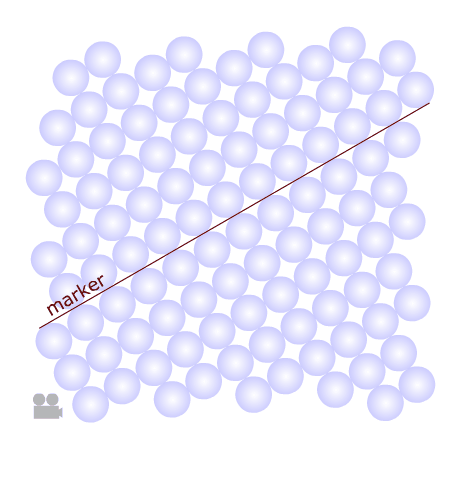 <!-- .element style="float: right" width="90%" --> </div> </div> <--o--> ### Plastic Shear zones <div> <div style='width:50%; float:left'> - Dominated by plastic (non-frictional) deformation mechanisms - Ductile, meaning that passive markers can be traced continuously through the zone. - Form in middle and lower crust. - In evaporites at shallow depths. - Can me many km thick. </div> <div style='width:50%; float:right'> 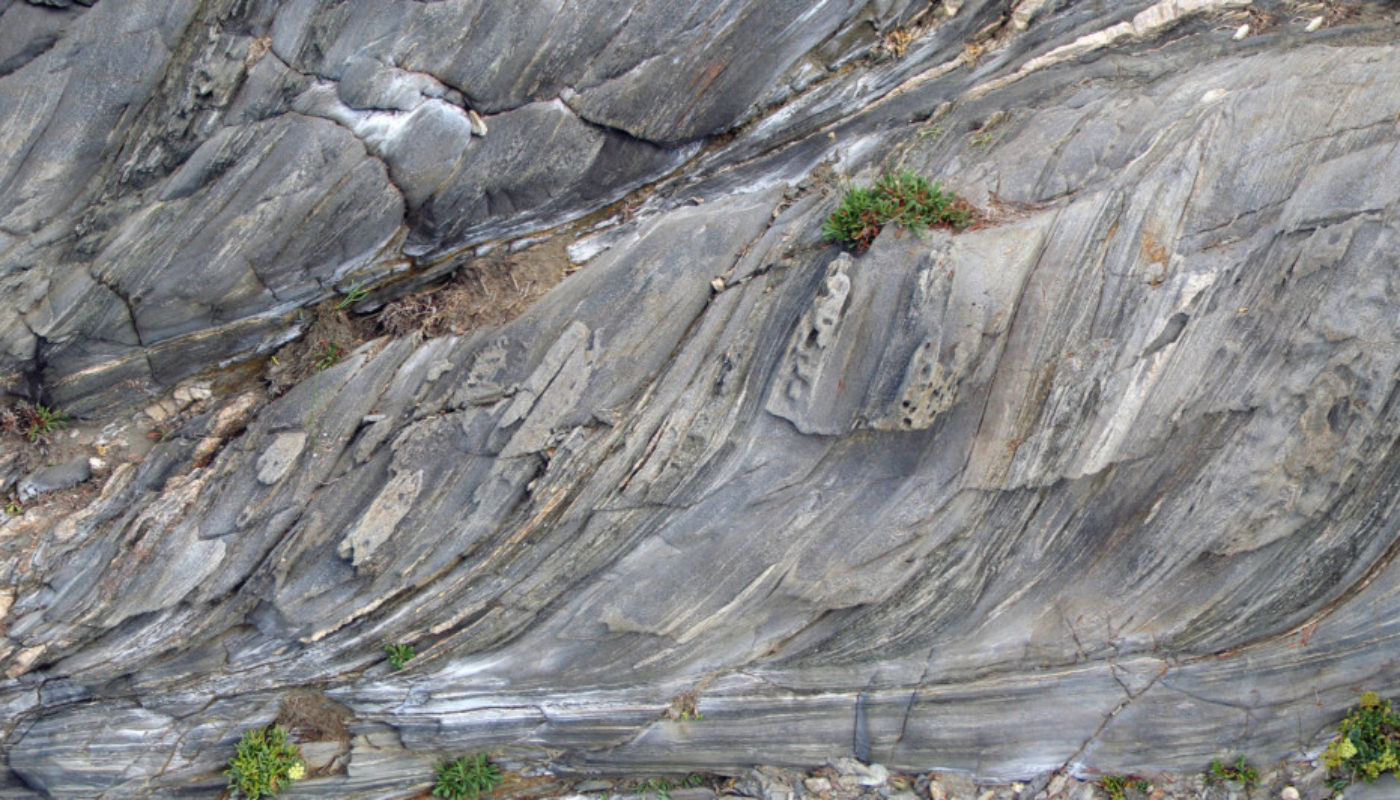 <!-- .element style="float: right" width="90%" --> </div> </div> <--o--> ### What Deformation Mechanisms are plastic? <div> <div style='width:50%; float:left'> Plastic deformation strains mineral without microfracture. Grains deform by the movement of imperfections known as **dislocation vacancies** Vacancy movement is diffusion, while dislocations move as atomic bounds are rearranged. Some important plastic processes: - Diffusional creep - Dislocation creep </div> <div style='width:50%; float:right'> 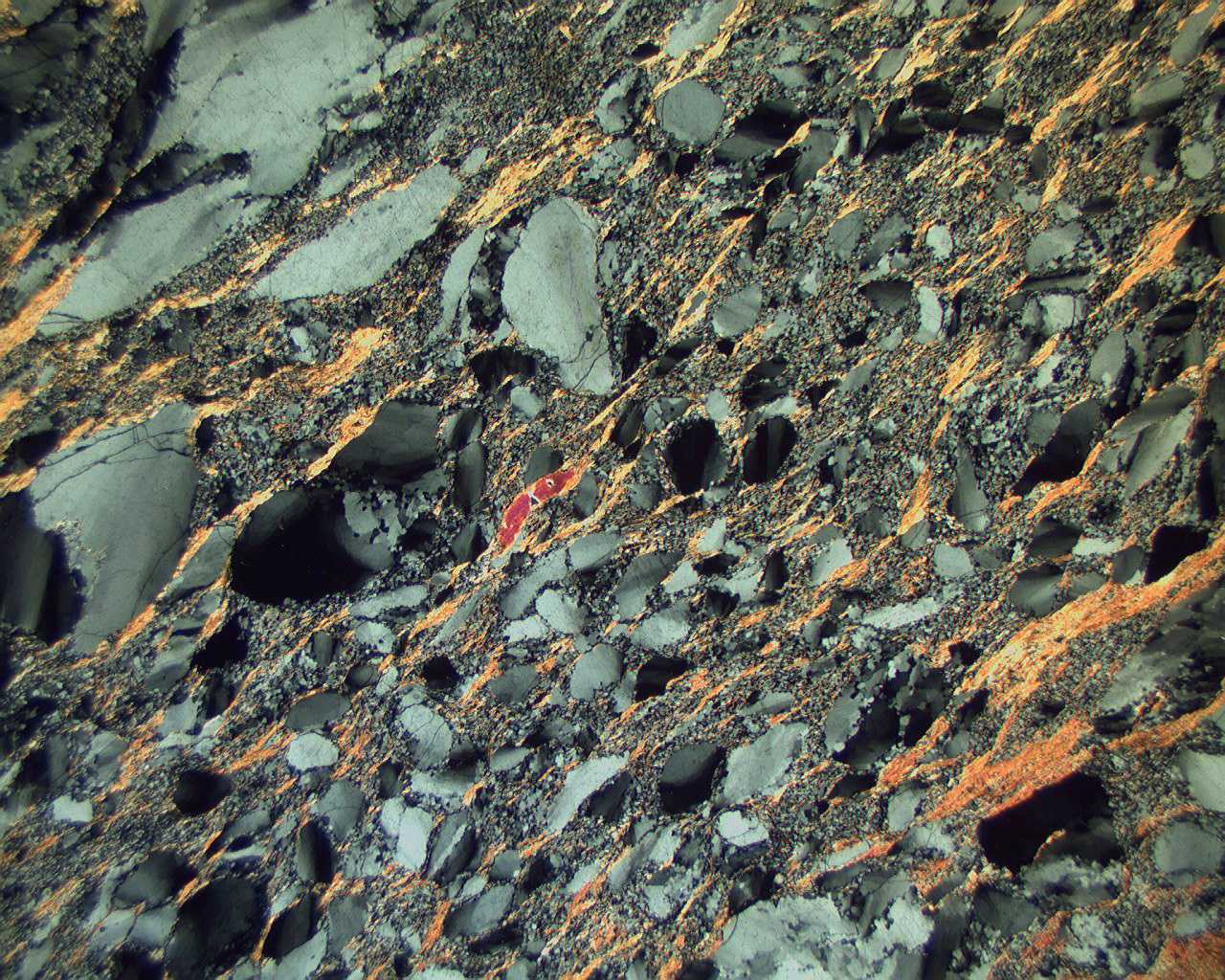 <!-- .element style="float: right" width="90%" --> </div> </div> <--o--> ### What Deformation Mechanisms are plastic? <div> <div style='width:50%; float:left'> *Example of plastic defromation of impoure quartzite (ruby Gap, Australia). Large quartz (graish) are remnants of the original texture. Dark shadows are expressions of intracrystalline strain (dislocation accumulations). New grains are much smaller. Credit: W. James Dunlap* </div> <div style='width:50%; float:right'>  <!-- .element style="float: right" width="90%" --> </div> </div> <--o--> ### Brittle shear zones <div> <div style='width:50%; float:left'> Brittle deformation dominates: **cataclasic flow** which involves micro-fracturing, frictional sliding, rigid rotations. We talk about **brittle** or **frictional shear zones**. - Markers are displaced by sharp discontinuities - Form at shallow crustal depths and involve brittle deformation mechanisms - Faults and fault zones are the most common types of shear zones. - A single slip surface (fault surface) is not a brittle shear zone because it does not have a thickness. </div> <div style='width:50%; float:right'>  <!-- .element style="float: right" width="90%" --> </div> </div> <--o--> <!-- .slide: data-background="Module-v-Ductile-Deformation/Figures-Shear_zones/Photos/ShearZone18.jpg" --> <--o--> ### Brittle-ductile shear zones <div> <div style='width:50%; float:left'> The transition between brittle and plastic deformation can be quite wide. We talk of **brittle-plastic shear zones** which can include both plastic and brittle deformation. Markers are affected by sharp discontinuities (slip surfaces). The discontinuities can be related to weak layers or laminae in the rock (e.g. layers rich in micas in gneiss) </div> <div style='width:50%; float:right'> 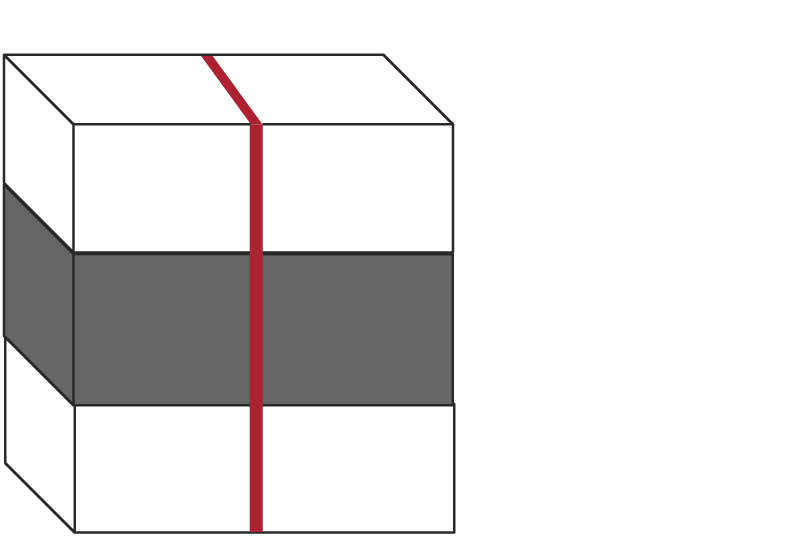 <!-- .element style="float: right" width="90%" --> </div> </div> <--o--> ### Brittle-ductile shear zones <div> <div style='width:50%; float:left'> - The offset of brittle components is comparable to the offset of ductile strain. - brittle components include Extension fractures, Veins, Slip surfaces - Some brittle-ductile shear zones involve a combination of plastic and brittle deformation mechanims. Others deform by means of brittle deformation only. </div> <div style='width:50%; float:right'> 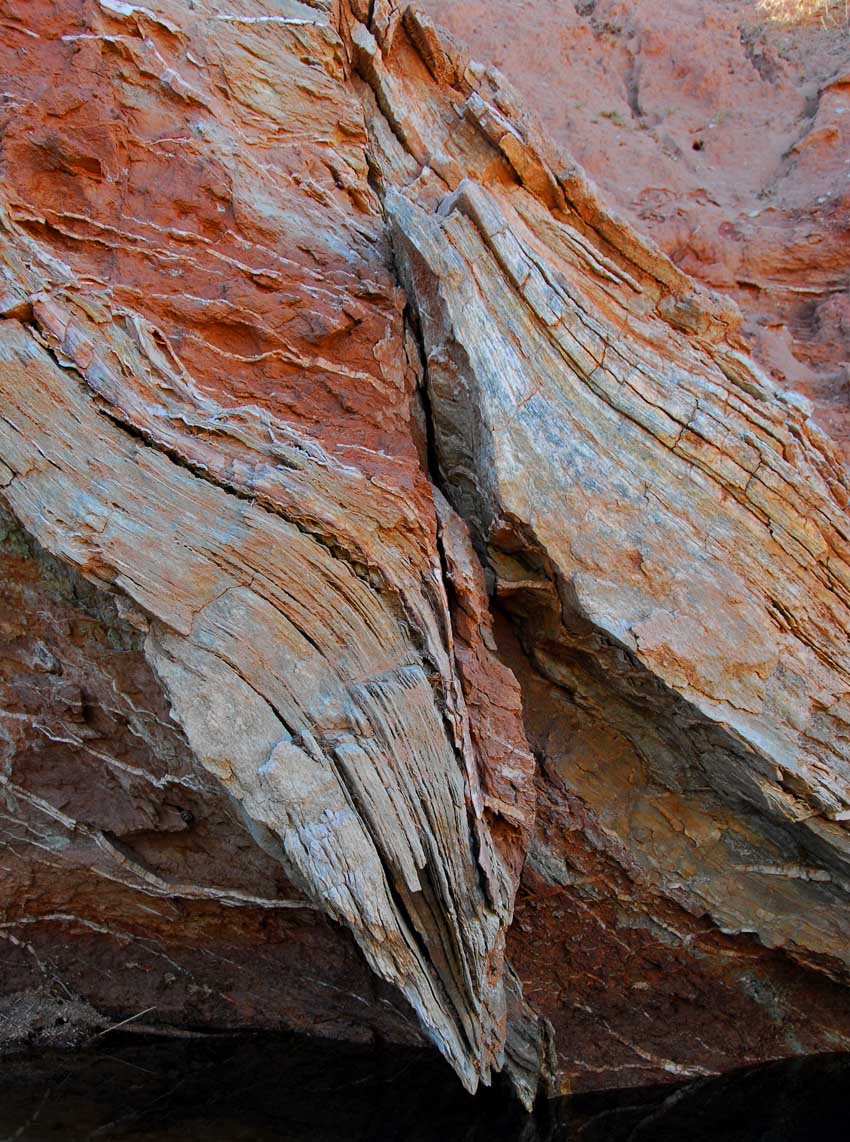 <!-- .element style="float: right" width="70%" --> </div> </div> <--o--> ### Example of Brittle-ductile shear zones 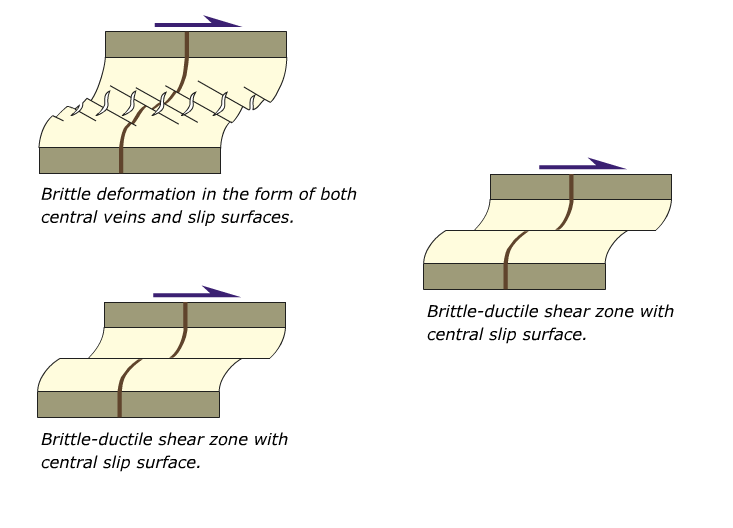 <!-- .element style="float: right" width="80%" --> <--o--> ### Vein arrays <div> <div style='width:50%; float:left'> A special type of Brittle-ductile shear zones - En-echelon filled fractures - Dominated by brittle deformation with some plastic mechanisms - Form near the plastic-brittle transition in the crust They typically form in the brittle upper crust (3-15km depth) </div> <div style='width:50%; float:right'> ) <!-- .element style="float: right" width="90%" --> </div> </div> <--o--> <!-- .slide: data-background="Module-v-Ductile-Deformation/Figures-Shear_zones/Photos/ShearZone15.jpg" --> <--o--> ### Ductile shear zones <div> <div style='width:50%; float:left'> Ductility is different than plasticity in the sense that it relates to continuity of original markers. **continuous deformation / strain**: marker layers can be traced through the zone at the mesoscopic scale. Most plastic shear zone preserve continuity, some brittle shear zones too. A **ductile shear zone** can deform brittelly and plastically. </div> <div style='width:50%; float:right'>  <!-- .element style="float: right" width="90%" --> </div> </div> <--o--> ### Ductile shear zones <div> <div style='width:50%; float:left'> Ductility is different than plasticity in the sense that it relates to continuity of original markers. **continuous deformation / strain**: marker layers can be traced through the zone at the mesoscopic scale. Most plastic shear zone preserve continuity, some brittle shear zones too. A **ductile shear zone** can deform britlely and plastically. </div> <div style='width:50%; float:right'> 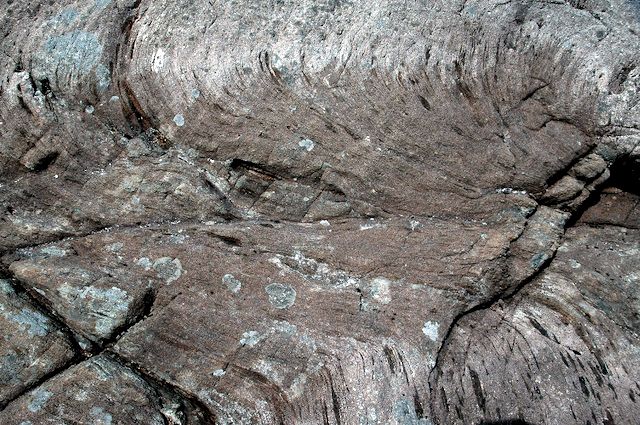 <!-- .element style="float: right" width="90%" --> </div> </div> <--o--> ### Ductile shear zones <div> <div style='width:50%; float:left'> In most cases the deformation is **semi-ductile** as we often observe small sharp discontinuities. Some shear zones show no continuity at all (heavily fractured zone, breccias). </div> <div style='width:50%; float:right'>  <!-- .element style="float: right" width="90%" --> </div> </div> <--o--> <!-- .slide: data-background="Module-v-Ductile-Deformation/Figures-Shear_zones/Photos/ShearZone5.jpg" --> <--o--> ## The ideal plastic shear zone - Limited by 2 planar boundaries that separate the area deformed from the surrounding rocks. - Perfectly ductile and involve **simple shear** with or without **compaction / dilation** - Present a foliation, lineation and evidence of strain variation. Ideal plastic shear zones are found in more or less isotropic rocks. <--o--> ## The ideal plastic shear zone The **foliation** initiate at a 45 degrees angle to the shear plane, perpendicular to the fastest shortening direction of the strain ellipsoid. It then rotates as the deformation increases and becomes parallel to the shear plane. A **stretching lineation** can develop and can be used to determine the X-axis. <--o--> ## Simple shear zones <div> <div style='width:50%; float:left'> - Plane strain deformation with $$W_k = 1$$ - No shortening nor stretching along or normal to the zone - ISA1 oriented at 45 degrees to the shear plane - Strain ellipsoid X-axis initiate at 45 degrees to the walls and progressively rotates towards parralelism </div> <div style='width:50%; float:right'>  <!-- .element style="float: right" width="70%" --> 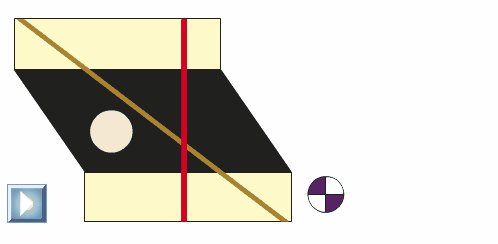 <!-- .element style="float: right" width="70%" --> </div> </div> <--o--> ## Instantaneous Stretching Axes in Simple Shear zones <div> <div style='width:50%; float:left'> - ISA are the directions of maximum, minimum and intermediate stretching experienced by a particle in a shear zone. The minimum axis can be called the maximum shortening direction, the intermediate axis is zero shortening or extension. - The ISA max and min are oriented at 45 degrees of the walls throughout the deformation. </div> <div style='width:50%; float:right'>  <!-- .element style="float: right" width="90%" --> </div> </div> <--o--> ## Strain Ellipse orientation in simple shear zones <div> <div style='width:50%; float:left'> - The strain ellipsoid can be reduced to an ellipse since no elongation occurs along the intermediate axis. - As strain accumulates, the strain ellipse rotates so that its long axis approach but never reach parallelism with the shear direction. - High strain means lower angle between the shear zone and the flattening X-Y plane. </div> <div style='width:50%; float:right'> 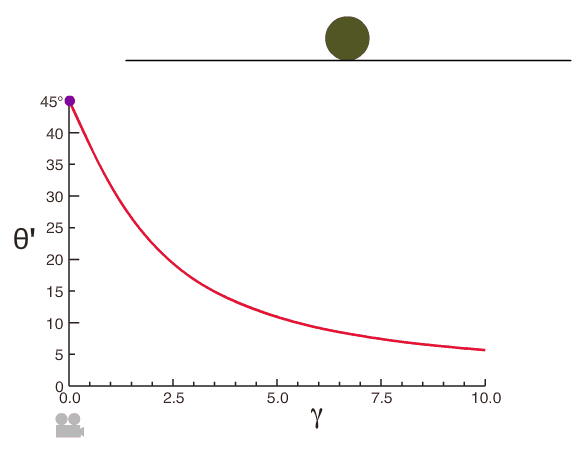 <!-- .element style="float: right" width="90%" --> </div> </div> <--o--> ## Foliation in simple shear zones - The foliation approximate the orientation of the X-Y plane. - The foliation can be traced through the shear zone and usually appear curved because of higher strain in the central parts.  <!-- .element style="float: right" width="90%" --> <--o--> ## Displacement in simple shear zones  <!-- .element style="float: right" width="90%" --> <--o--> ## Dilation / Compaction zones <div> <div style='width:50%; float:left'> A zone that compacts by wall-normal displacement is a **compaction zone** The deformation is planar and co-axial with zero vorticity. - Shortening across (not along) the zone - ISA max normal to the shear zone. - Long axis of the strain ellipsoid initiate and remain parallel to the walls. - Passive planar marker that initially made an angle $\beta$ with the zone obtains a new angle $\beta'$ that is related to the dilation through: $$\beta'=cot \beta/(1+\delta)$$ </div> <div style='width:50%; float:right'> 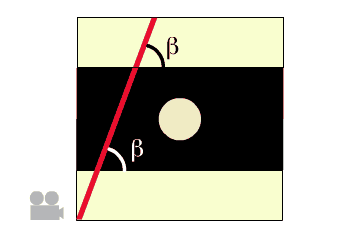 <!-- .element style="float: right" width="90%" --> </div> </div> <--o--> ## Compactional Shear <div> <div style='width:50%; float:left'> Compaction can combine with Simple shear. The compaction conponent will close walls as the zone develops but this will be counteracted by general widening of the zone as strain accumulates. </div> <div style='width:50%; float:right'>  <!-- .element style="float: right" width="90%" --> </div> </div> <--o--> ## Instantaneous Stretching Axes in Compactional Shear zones <div> <div style='width:50%; float:left'> - Compaction Rotates ISA so that ISA max (The direction of fastest stretching) makes an angle $\theta$ withthe shear plane that is les tham 45 degrees. - The stronger the compaction, the larger the deviation from 45 degrees. - For dilational simple shear the angle $\theta$ is larger than 45 degrees. </div> <div style='width:50%; float:right'> 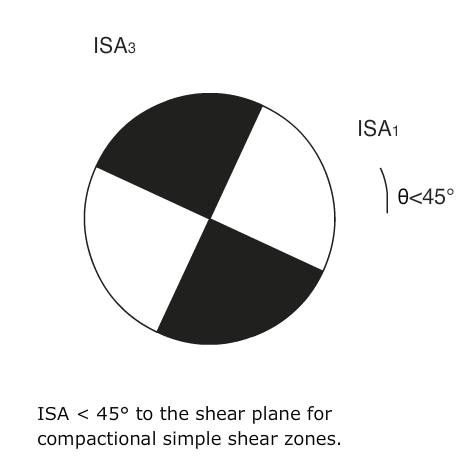 <!-- .element style="float: right" width="90%" --> </div> </div> <--o--> ## Instantaneous Stretching Axes in Compactional Shear zones <div> <div style='width:50%; float:left'> - Compaction Rotates ISA so that ISA max (The direction of fastest strecthing) makes an angle $\theta$ withthe shear plane that is les tham 45 degrees. - The stronger the compaction, the larger the deviation from 45 degrees. - For dilational simple shear the angle $\theta$ is larger than 45 degrees. </div> <div style='width:50%; float:right'> 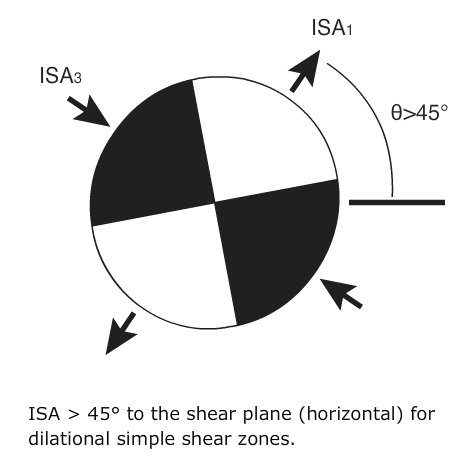 <!-- .element style="float: right" width="90%" --> </div> </div> <--o--> ### Pure Shear <div> <div style='width:50%; float:left'> Can have curved and non-parallel walls, their displacement profile vary as we move along the zone. **Extrusion** of material along the zone causes a compatibility problem. This can be solved if the shear zone thins or thickens laterally during deformation. Material can thus flow in the thickening areas. Another possibility is to have a free domain where material can extrude. **Extrusion** is an effect of pure shear that also occurs in other deformation involving pure shear (e.g. Sub-simple shear) </div> <div style='width:50%; float:right'> 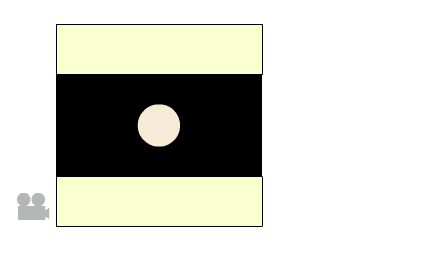 <!-- .element style="float: right" width="90%" --> </div> </div> <--o--> ### Pure Shear <div> <div style='width:50%; float:left'> Pure shear zones have been suggested to occur at the base of thrust nappes when the nappes collapse under their own weight. It is probably more common to have a combination of Pure and Simple shear. </div> <div style='width:50%; float:right'>  <!-- .element style="float: right" width="90%" --> </div> </div> <--o--> ### Sub-Simple Shear <div> <div style='width:50%; float:left'> **Combination of Pure and Simple Shear** **Simple shear** is involved in most shear zones. However, vorticity analysis of shear zones show that a component of **Pure shear** is common. </div> <div style='width:50%; float:right'> 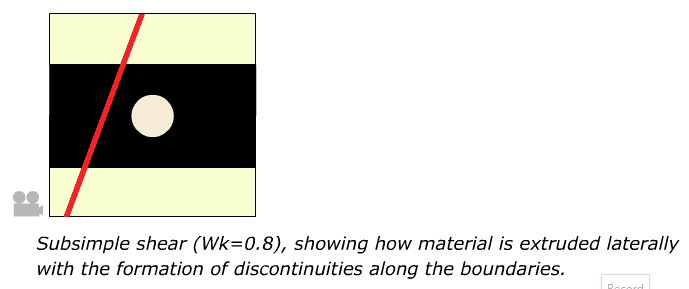 <!-- .element style="float: right" width="90%" --> </div> </div> <--o--> ### Sub-Simple Shear and ISA #### Instantaneous Stretching Axis - ISA max and ISA min are oblique to the shear zone walls. - ISA do not rotate. They stay fixed during steady state deformation - The orientation of ISA specify the amounts of Pure and Simple shear - In Brittle-ductile deformation zones with tension gashes, the tips of the veins are perpendicular to ISA max. **The orientation of ISA is constant across the zone, regardless of strain** <--o--> ### Sub-Simple Shear and ISA #### Instantaneous Stretching Axis 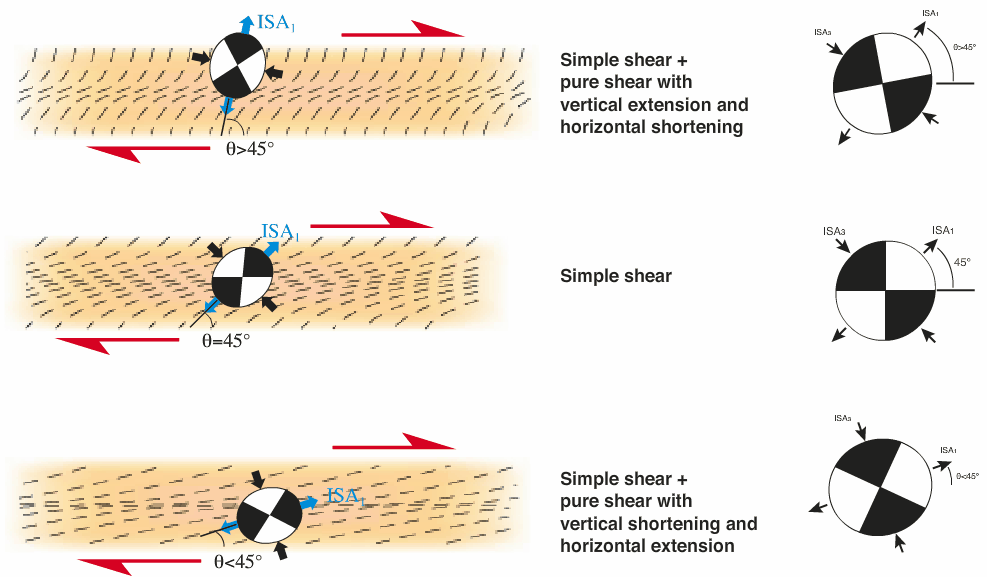 <!-- .element style="float: center" width="90%" --> <--o--> ### Sub-Simple Shear #### Rotation of passive markers <div> <div style='width:50%; float:left'> Technically, passive markers become discontinuous along the margins of a subsimple shear zone. </div> <div style='width:50%; float:right'> 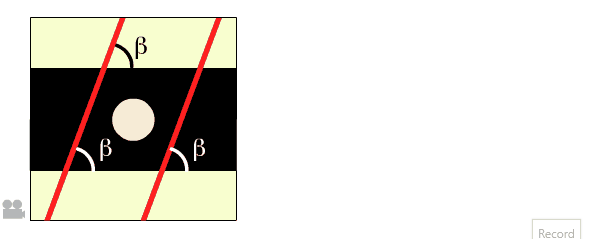 <!-- .element style="float: right" width="90%" --> </div> </div> <--o--> ### Growth of Shear Zones <div> <div style='width:50%; float:left'> Shear zones grow from small shear bands just as fault grow from small fractures. We usually find that long and thick shear zones show more displacements than short and narrow ones. **How do they grow?** **Which part of the shear zone recorded the last part of the strain history?** - Borders? - Central part? No simple answers but we have models. </div> <div style='width:50%; float:right'>  <!-- .element style="float: right" width="90%" --> </div> </div> <--o--> ### Growth of Shear Zones ### Type-I <div> <div style='width:50%; float:left'> - Expand into its walls and thus becomes thicker with increasing offset. - The central part is inactive as the walls are being strained. - Strain profile shows a flat peak in the central part of the shear zone. - This is typical of strain hardening. </div> <div style='width:50%; float:right'> 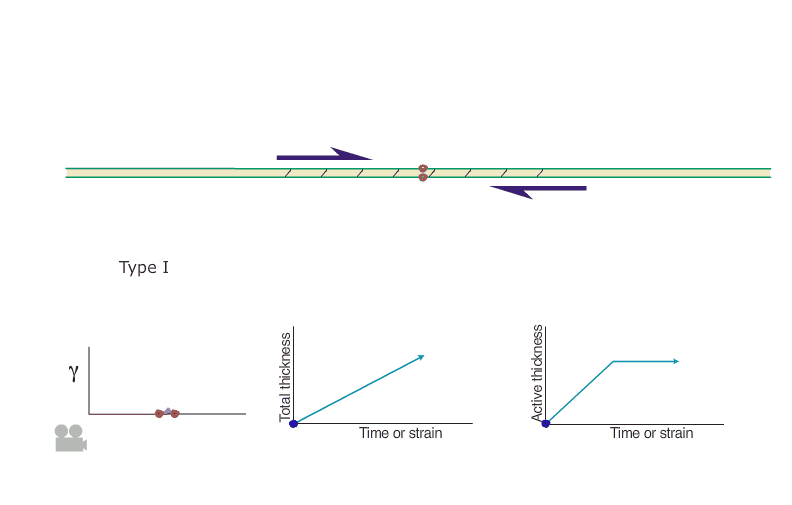 <!-- .element style="float: right" width="90%" --> </div> </div> <--o--> ### Growth of Shear Zones ### Type-II <div> <div style='width:50%; float:left'> - Expand only for a limited period of time - Margins become inactive, deformation is concentrated in the central part. - The strain profile shows a steep peak in the central part of the shear zone. - This is typical of strain softening. </div> <div style='width:50%; float:right'>  <!-- .element style="float: right" width="90%" --> </div> </div> <--o--> ### Growth of Shear Zones ### Type-III <div> <div style='width:50%; float:left'> - Initiate with a certain thickness. - The shear zone thickness remain constant and the entire zone is always active. - The strain profile is flat. - There is no significant hardening or softening. - Some Kink-bands may represent zones of this type. </div> <div style='width:50%; float:right'>  <!-- .element style="float: right" width="90%" --> </div> </div> <--o--> ### Growth of Shear Zones ### Type-IV <div> <div style='width:50%; float:left'> - Expand continuously during their lifetime. - The entire zone is always active. - The strain profile is a steep peak through the zone. </div> <div style='width:50%; float:right'> 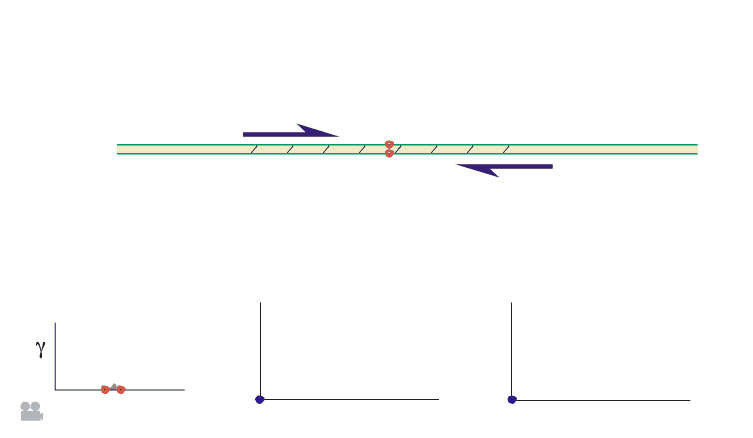 <!-- .element style="float: right" width="90%" --> </div> </div> <--o--> ## Mylonites <div> <div style='width:50%; float:left'> Highly strained rocks in the central part of some plastic shear zones. Pre-existing structures and textures are totally flattened and transposed and are hard to identify. </div> <div style='width:50%; float:right'> 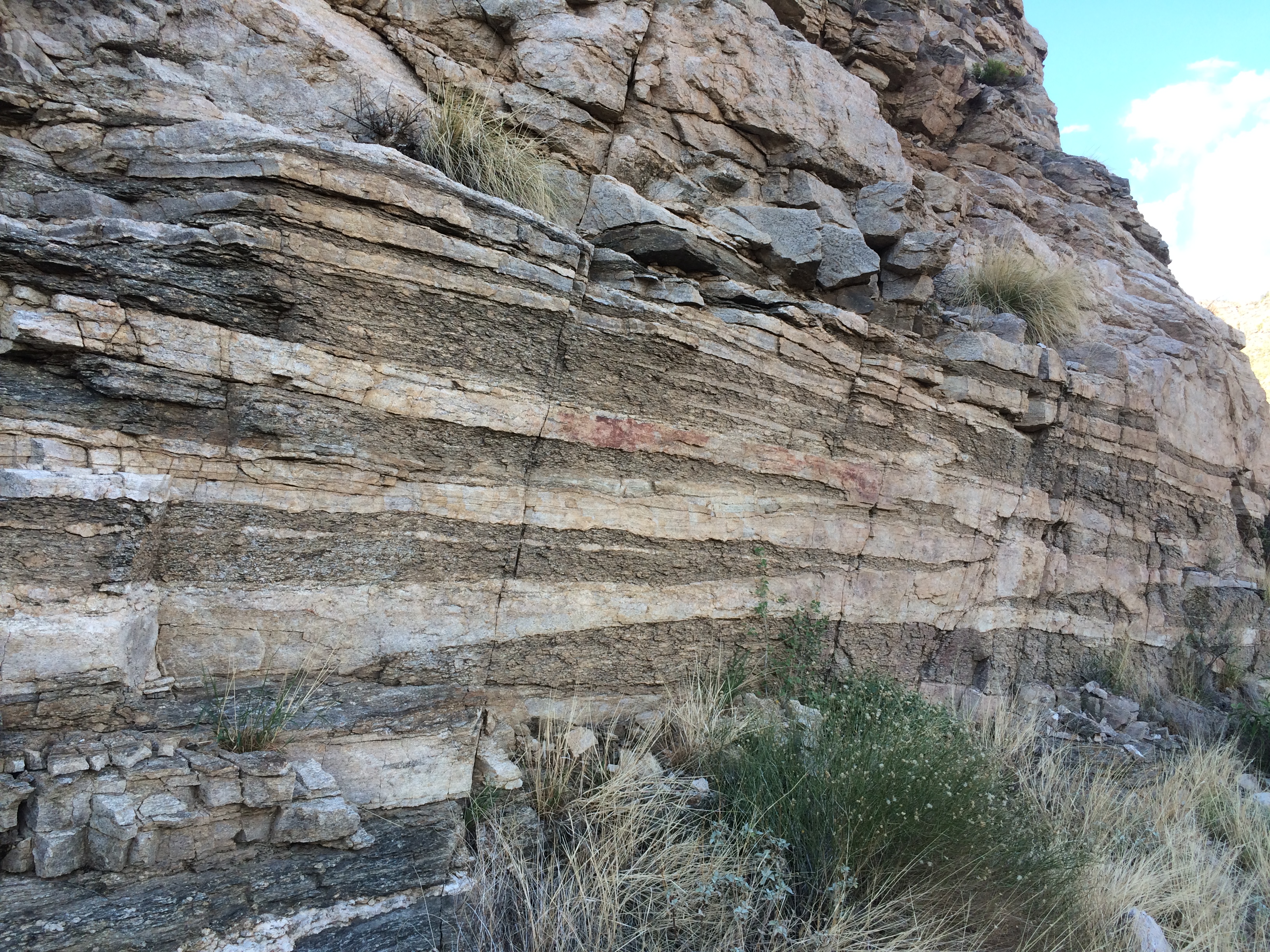 <!-- .element style="float: right" width="90%" --> </div> </div> <--o--> <!-- .slide: data-background="Module-v-Ductile-Deformation/Figures-Shear_zones/Photos/Mylonites.jpeg" --> <--o--> ## Kinematic Indicators Wide range of indicators  <!-- .element style="float: center" width="100%" --> <--o--> ## Kinematic indicators ### Asymmetric structures <div> <div style='width:50%; float:left'> The (a)symmetry of mylonitic structures can be used to determine the sense of shear and the degree of coaxiality of the deformation. </div> <div style='width:50%; float:right'> 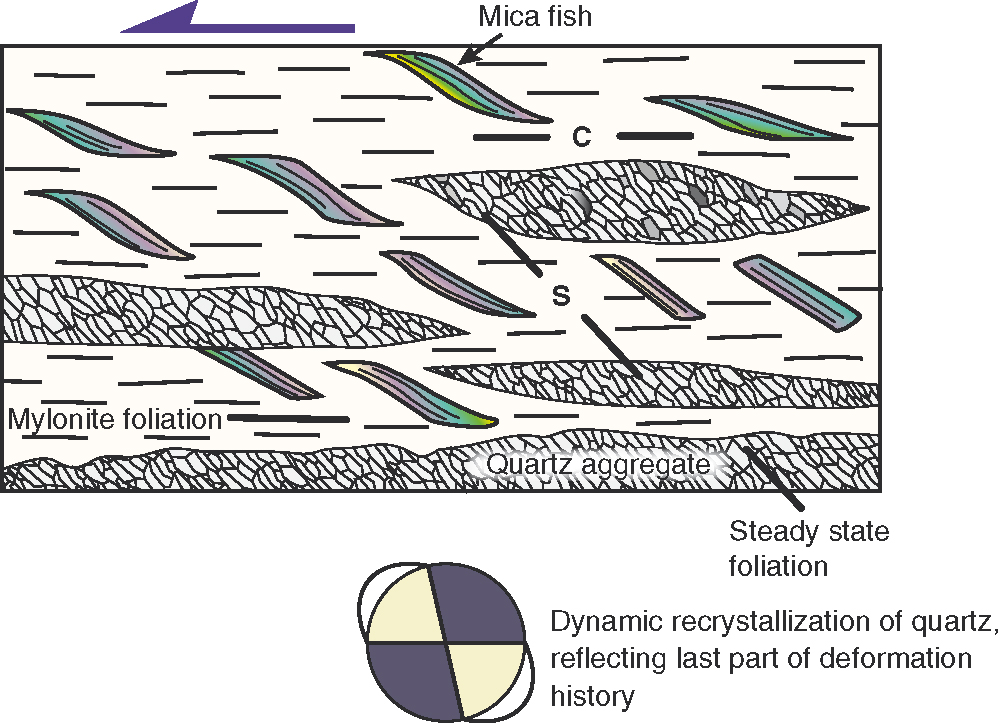 <!-- .element style="float: right" width="90%" --> </div> </div> <--o--> ## Kinematic indicators <div> <div style='width:50%; float:left'> ### Deflected markers Rotation of planar marker from an area of low strain to an area of high strain provide very reliable criteria for sense of shear. </div> <div style='width:50%; float:right'> 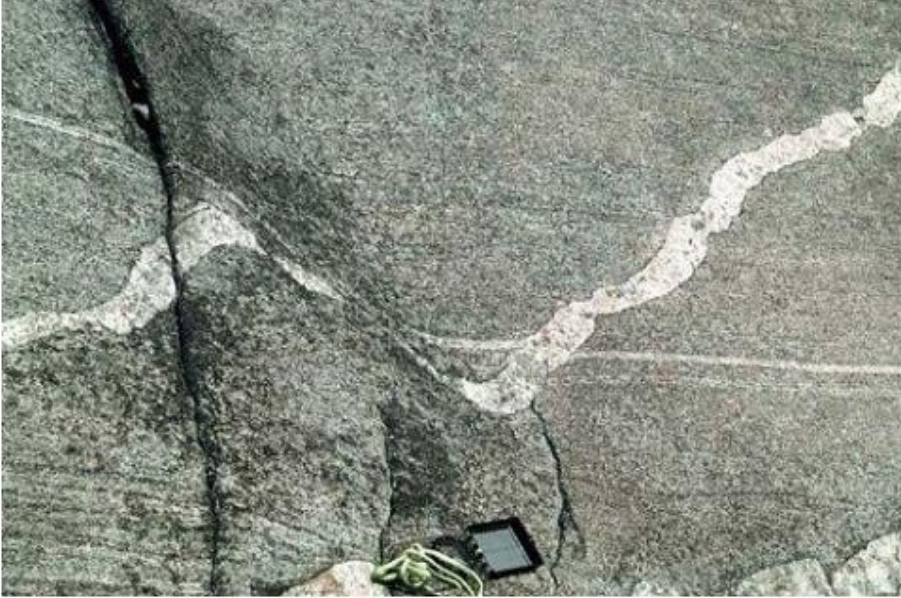 <!-- .element style="float: right" width="90%" --> </div> </div> <--o--> ## Kinematic indicators <div> <div style='width:50%; float:left'> ### Mylonitic foliation and shear bands (S-C structures) The foliation usually trace the XY-plane of the strain ellipsoid. The foliation (S for shistosity) curves in and out of the C-surfaces (C for 'cisaillement', french for 'shear') and the sense of deflection reflect the sense of shear of the shear-zone. It is important to remember that C structures form relatively late and may only reflect the last stage of deformation. </div> <div style='width:50%; float:right'> 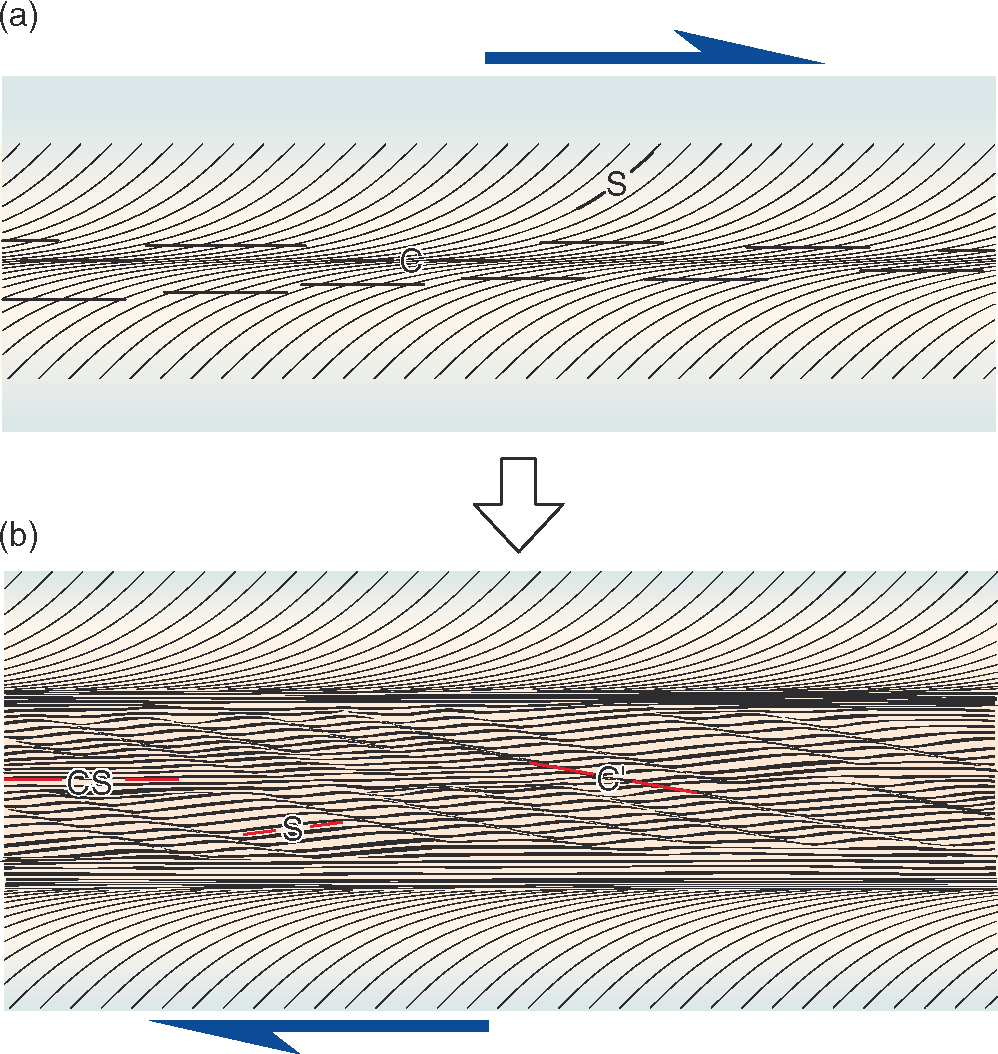 <!-- .element style="float: right" width="90%" --> </div> </div> <--o--> ## Kinematic indicators ### Microscale foliation Mineral aggregates are usually part of the foliation but the main axis of the deformed grain define an oblique foliation. Result of 2 competing effects: - strain produced by grain elongation - dynamic recristallisation The oblique foliation reflect the last increment of deformation while the foliation integrates the entire deformation history. Any angle with the foliation indicates that the deformation is non coaxial and can help in determining the degree of non coaxiality. It can also help to determine the sense of shear. <--o--> ## Kinematic indicators <div> <div style='width:50%; float:left'> ### Mica fish Type of S-C structure - Tails curve away from the genral orientation - The asymmetry indicates the sense of shear </div> <div style='width:50%; float:right'> 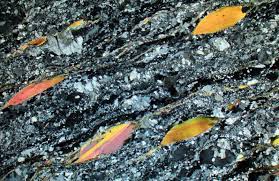 <!-- .element style="float: right" width="90%" --> </div> </div> <--o--> ## Kinematic indicators ### Foliation fish and foliation boudinage Parts of strongly foliated mylonite back-rotate with respect to the shear direction and create structures similar to mica-fish. <--o--> ## Kinematic indicators <div> <div style='width:50%; float:left'> ### Boudinage Rotated boudins can be used to determine the sense of shear. </div> <div style='width:50%; float:right'> 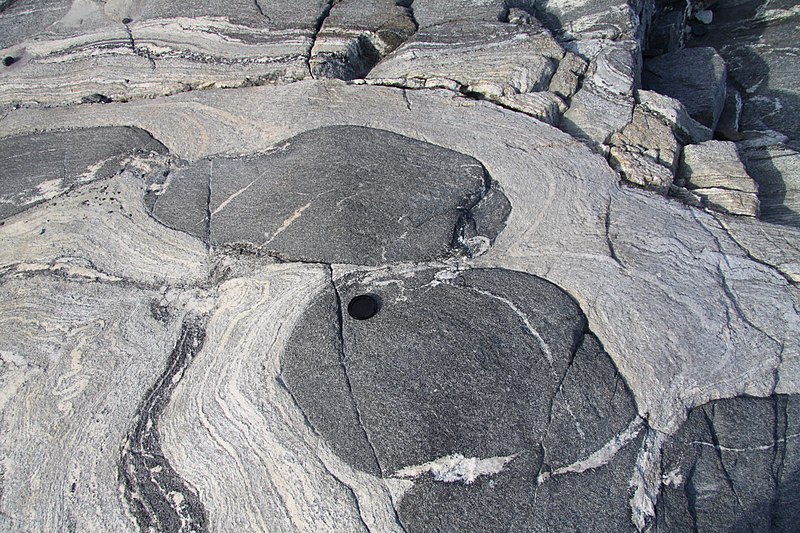 <!-- .element style="float: right" width="90%" --> </div> </div> <--o--> <!-- .slide: data-background="Module-v-Ductile-Deformation/Figures-Shear_zones/Photos/RotatedBoudinage.jpeg" --> <--o--> ## Kinematic indicators <div> <div style='width:50%; float:left'> ### Porphyroclastes Recrystallised material around large mineral can form tails. Asymmetry highlight non-coaxial deformation with the final shape being a function of Wk. </div> <div style='width:50%; float:right'>  <!-- .element style="float: right" width="90%" --> </div> </div> <--o--> <!-- .slide: data-background="Module-v-Ductile-Deformation/Figures-Shear_zones/Photos/ShearZone5.jpg" --> <--v--> $\delta$-type porphyroclast indicating roattion during top-to-the-left shearing, consistent with the asymmetry of the small scale folds to the right** <--o--> ## Kinematic indicators <div> <div style='width:50%; float:left'> ### Folds and cleavage Asymmetric folds and associated cleavages within the shear zone can give the sense of shear. The mylonitic foliation is often folded. Pre-existing structures (eg dikes) *Fold formed in non-coaxial deformation in gneisses. The vergence of teh asymmetric folds indicate top-to-the-left transport** </div> <div style='width:50%; float:right'> 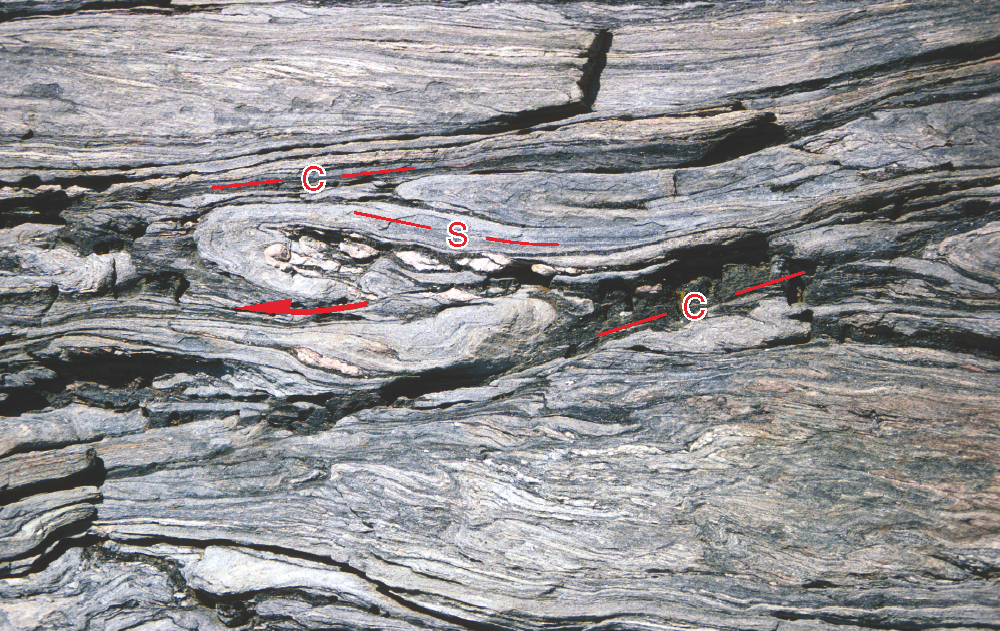 <!-- .element style="float: right" width="90%" --> </div> </div> <--o--> ## Kinematic indicators <div> <div style='width:50%; float:left'> ### Quarter structures Association of contraction and extension structures around tectonic lenses. </div> <div style='width:50%; float:right'> 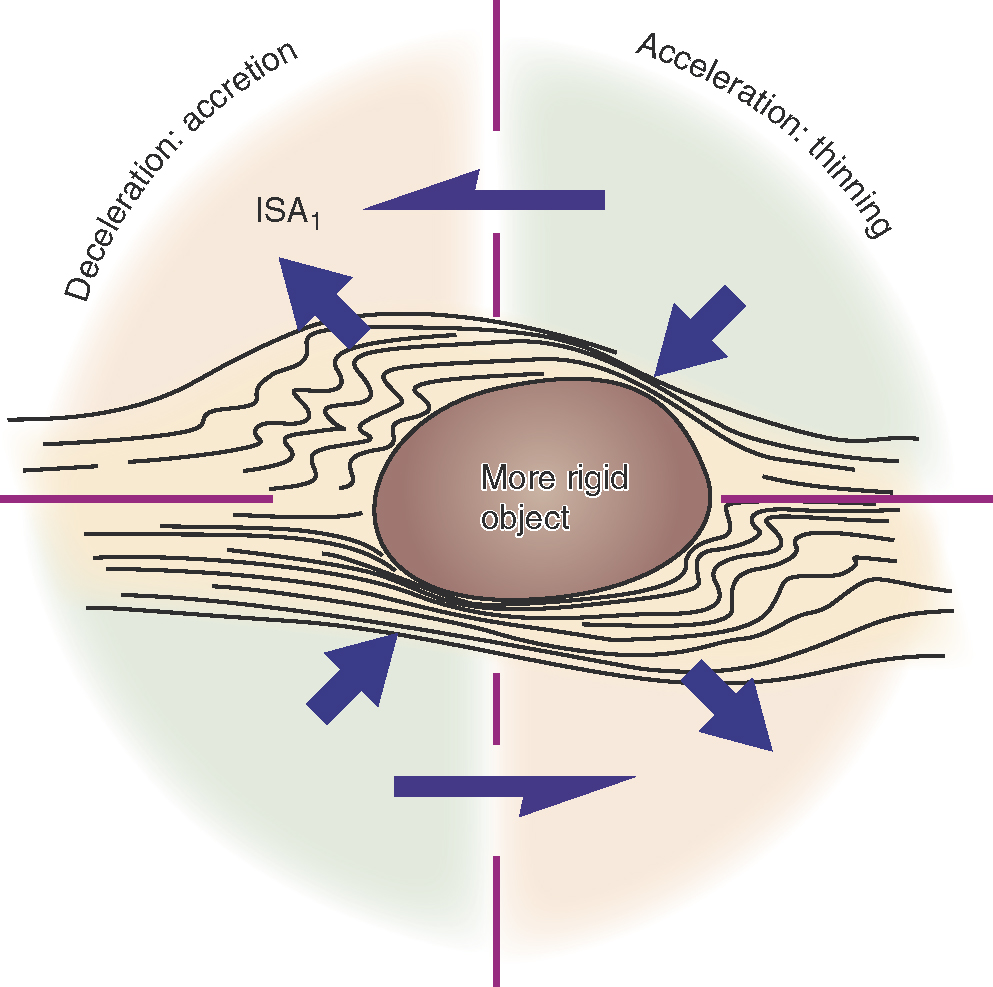 <!-- .element style="float: right" width="90%" --> </div> </div> <--o--> ## Kinematic indicators <div> <div style='width:50%; float:left'> ### Crystallographic orientation Measure of C-axis orientations of quartz grains. Asymmetry with respect to foliation gives sense of shear. </div> <div style='width:50%; float:right'>  <!-- .element style="float: right" width="90%" --> </div> </div> <--o--> ## Kinematic indicators <div> <div style='width:30%; float:left'> ### Fiber and veins Orientation of extensional veins indicate the sense of shear. Fibers are usually more reliable. If the deformation is non-coaxial, the veins rotate and become sygmoides that can be used to determine the sense of shear. </div> <div style='width:70%; float:right'>  <!-- .element style="float: right" width="90%" --> </div> </div> <--o--> ## Kinematic indicators - Tiling of objects: Require large densities of crystals. Common in porphyritic magmatic rocks. - Shear transfer structures - Micro-faulted mineral grains <--o--> ## Summary - Shear zones occur at all scale and crutal depths. - Shallow shear zones deform by brittle mechanisms. - Deeper shear zones deform by plastic mechanims. - The ideal shear zones involves simple shear and perhaps volume change but this is a very simplified view. - Sub-simple shear zones are (most?) common. - Most shear zones show an increase in strain from the margin to the center. - Several growth pattern can be envisaged. - Most shear zones grow wider... but strain softening may lead to a narrowing of the zone over time.